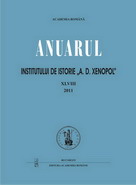„CORPUL NAȚIUNII” ȘI „CORPUL POLITIC” ÎN UNELE TEXTE DIN PRIMA JUMĂTATE A SECOLULUI XIX DIN ȚARA ROMÂNEASCĂ ȘI MOLDOVA. CONSIDERAȚII PRELIMINARE
THE “BODY OF THE NATION” AND THE “BODY POLITIC” IN SOME TEXTS FROM THE FIRST HALF OF THE NINETEENTH CENTURY FROM WALLACHIA AND MOLDAVIA
Author(s): Alexandru-Florin PlatonSubject(s): History
Published by: Editura Academiei Române
Keywords: corporal representations, Principalities, ethnical unity, communal life, cultural meaning
Summary/Abstract: How did the educated elites from the Romanian regions, during the Middle Ages and the modern era, picture the forms of communal life and the structures which they lived in? Or – better said – are there, within the local collective imagination, hints – no matter how basic – able, if not to certify, at least to suggest the existence of such representations? Unlike the western catholic and protestant world, where the political articulation of the society and the ways of wielding the monarchical power constituted, even from the beginning of the Middle Ages until late in the seventeenth century (and, of course, afterwards), the object of some mostly corporal repre-sentations, being understood through an analogy with the ways the human body worked and was structured, in the society of the three Principalities and, roughly speaking, in the post-Byzantine area, such representations are extremely seldom, as if the ruling elites from here had been incapable of thinking the polity (or, more exactly, the “state”) as a “public thing”, investing it with the attributes of a so-called ontological reality, separated from the group interests. In Moldavia and Wallachia, the earliest representations of both the ethnical unity and the political organization date from the beginning of the nineteenth century, being found, as fragments, in some of the writings of Naum Râmniceanu, Dionisie Eclesiarhul, Ionică Tăutul, as well in texts of different nature (proclamations, correspondence, journal articles, historical writings, etc.) from the period of the 1848 Revolution and the one preceding it. The present paper analyzes the expressions of body representation within all these texts, interpreting them with respect to their political and cultural meaning.
Journal: Anuarul Institutului de Istorie »A.D. Xenopol« - Iaşi
- Issue Year: L/2013
- Issue No: 50
- Page Range: 293-304
- Page Count: 17
- Language: Romanian

